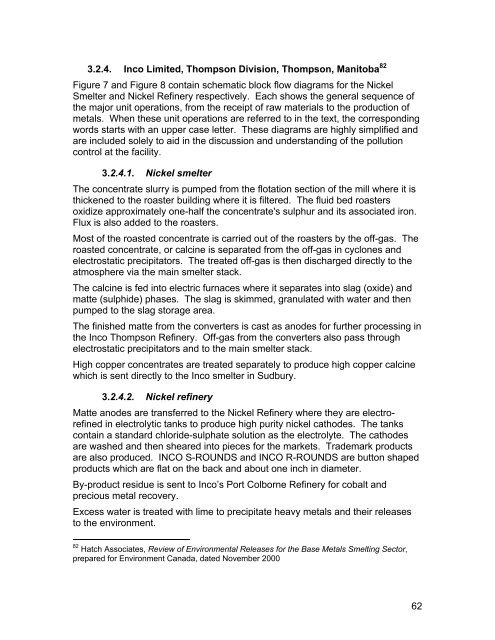(MERAF) for the Base Metals Smelting Sector - CCME
(MERAF) for the Base Metals Smelting Sector - CCME
(MERAF) for the Base Metals Smelting Sector - CCME
Create successful ePaper yourself
Turn your PDF publications into a flip-book with our unique Google optimized e-Paper software.
3.2.4. Inco Limited, Thompson Division, Thompson, Manitoba 82<br />
Figure 7 and Figure 8 contain schematic block flow diagrams <strong>for</strong> <strong>the</strong> Nickel<br />
Smelter and Nickel Refinery respectively. Each shows <strong>the</strong> general sequence of<br />
<strong>the</strong> major unit operations, from <strong>the</strong> receipt of raw materials to <strong>the</strong> production of<br />
metals. When <strong>the</strong>se unit operations are referred to in <strong>the</strong> text, <strong>the</strong> corresponding<br />
words starts with an upper case letter. These diagrams are highly simplified and<br />
are included solely to aid in <strong>the</strong> discussion and understanding of <strong>the</strong> pollution<br />
control at <strong>the</strong> facility.<br />
3.2.4.1. Nickel smelter<br />
The concentrate slurry is pumped from <strong>the</strong> flotation section of <strong>the</strong> mill where it is<br />
thickened to <strong>the</strong> roaster building where it is filtered. The fluid bed roasters<br />
oxidize approximately one-half <strong>the</strong> concentrate's sulphur and its associated iron.<br />
Flux is also added to <strong>the</strong> roasters.<br />
Most of <strong>the</strong> roasted concentrate is carried out of <strong>the</strong> roasters by <strong>the</strong> off-gas. The<br />
roasted concentrate, or calcine is separated from <strong>the</strong> off-gas in cyclones and<br />
electrostatic precipitators. The treated off-gas is <strong>the</strong>n discharged directly to <strong>the</strong><br />
atmosphere via <strong>the</strong> main smelter stack.<br />
The calcine is fed into electric furnaces where it separates into slag (oxide) and<br />
matte (sulphide) phases. The slag is skimmed, granulated with water and <strong>the</strong>n<br />
pumped to <strong>the</strong> slag storage area.<br />
The finished matte from <strong>the</strong> converters is cast as anodes <strong>for</strong> fur<strong>the</strong>r processing in<br />
<strong>the</strong> Inco Thompson Refinery. Off-gas from <strong>the</strong> converters also pass through<br />
electrostatic precipitators and to <strong>the</strong> main smelter stack.<br />
High copper concentrates are treated separately to produce high copper calcine<br />
which is sent directly to <strong>the</strong> Inco smelter in Sudbury.<br />
3.2.4.2. Nickel refinery<br />
Matte anodes are transferred to <strong>the</strong> Nickel Refinery where <strong>the</strong>y are electrorefined<br />
in electrolytic tanks to produce high purity nickel cathodes. The tanks<br />
contain a standard chloride-sulphate solution as <strong>the</strong> electrolyte. The cathodes<br />
are washed and <strong>the</strong>n sheared into pieces <strong>for</strong> <strong>the</strong> markets. Trademark products<br />
are also produced. INCO S-ROUNDS and INCO R-ROUNDS are button shaped<br />
products which are flat on <strong>the</strong> back and about one inch in diameter.<br />
By-product residue is sent to Inco’s Port Colborne Refinery <strong>for</strong> cobalt and<br />
precious metal recovery.<br />
Excess water is treated with lime to precipitate heavy metals and <strong>the</strong>ir releases<br />
to <strong>the</strong> environment.<br />
82 Hatch Associates, Review of Environmental Releases <strong>for</strong> <strong>the</strong> <strong>Base</strong> <strong>Metals</strong> <strong>Smelting</strong> <strong>Sector</strong>,<br />
prepared <strong>for</strong> Environment Canada, dated November 2000<br />
62
















